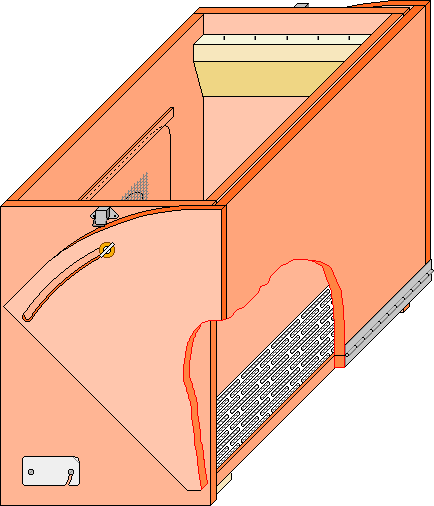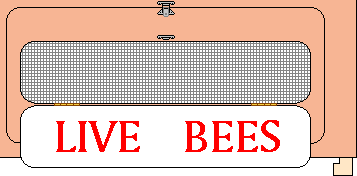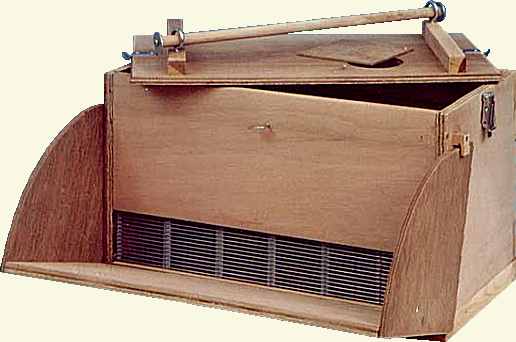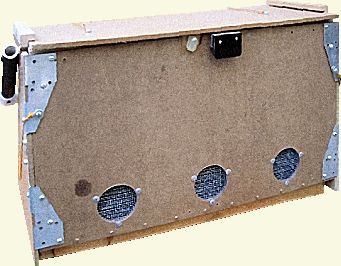| |
Marburg Swarm Box
The details given here are for the construction of a box
that will carry six British Standard frames, this enables such
carrying as an additional capability to the main design features. As
the bees will not be kept in the box for extended periods it is not
important to adhere to normal bee space practice.
The basic internal dimensions of the box are 434 mm x
216 mm, if you are using frames other than British Standard you
will need to adjust the length to suit your top bars.
|
|---|
The material used for the walls and funnel parts is
9 mm thickness waterproof exterior grade plywood which is
adequately rigid. Although this type of box is heavier than the
standard version it will only be used as a carrying box on a few
occasions, but such a carrying facility is still useful to
incorporate.
The frame runners should be the same as those detailed on
the page that covers the
standard version.
Depending on your precise design, it may be possible to use the frame
runners to lock the bolt heads in place instead of using separate
blocks.
|
No 4 Woodscrews and PVA glue are used for construction.
The body of the box is made 240 mm deep inside (from
rim to mesh) similar to the standard version. The opening hatch side
of the box overlaps the base by 9 mm. The ends overlap the base
by 43 mm. The funnel side does not reach the base, but has a
panel of queen excluder fitted. Depending on whether this is a
perforated sheet excluder or a wire one, a fillet of 8 mm or
6 mm will be needed to cover the board slot and as a spacer for
the strip that acts as a mount for the piano hinge. The fit at this
point is critical and should be adjusted by planing or application of
cardboard spacing strips in order that the piano hinge mount's outer
face is exactly as proud of the body as the upper portion of this side.
The top curved edges of the quadrants may require relieving
where the toggle fasteners are fitted.
| |

|
|---|
 The funnel and its end quadrants are also 9 mm ply
with the inside measurement of the funnel 1.6 mm to 2 mm
longer than the box side so that it opens and closes without dragging.
The action of this opening and closing is made easy and smooth by
using plastic spacer washers as shown. The wing nuts and the bolts
that act as studs can be brass or stainless steel. The bolts are held
captive and are stopped from rotating by sinking the heads into wooden
blocks that are themselves glued and screwed to the inside of the box.
The hexagonal recess is easily formed by drilling a blind hole that
has a diameter the same as the 'across the flats' dimension of the
bolt head. The bolt head is placed on the recess and a mallet blow
will leave an impression of the hexagon, which can be carved out using
a chisel. The quadrants can be marked out with easily using a trammel
formed from a strip of 5 mm ply with a pivot hole at one end and
three other holes that will accept the point of a pencil. These three
holes are the inner and outer edge of the curved slot and the outer
edge of the quadrant itself. The quadrant is made much wider than
required just for opening, so that the curved slot is not exposed
when the funnel is open. This stops light entering via the slots and
avoids the complication of bees getting in the way when you wish to
close it.
The funnel and its end quadrants are also 9 mm ply
with the inside measurement of the funnel 1.6 mm to 2 mm
longer than the box side so that it opens and closes without dragging.
The action of this opening and closing is made easy and smooth by
using plastic spacer washers as shown. The wing nuts and the bolts
that act as studs can be brass or stainless steel. The bolts are held
captive and are stopped from rotating by sinking the heads into wooden
blocks that are themselves glued and screwed to the inside of the box.
The hexagonal recess is easily formed by drilling a blind hole that
has a diameter the same as the 'across the flats' dimension of the
bolt head. The bolt head is placed on the recess and a mallet blow
will leave an impression of the hexagon, which can be carved out using
a chisel. The quadrants can be marked out with easily using a trammel
formed from a strip of 5 mm ply with a pivot hole at one end and
three other holes that will accept the point of a pencil. These three
holes are the inner and outer edge of the curved slot and the outer
edge of the quadrant itself. The quadrant is made much wider than
required just for opening, so that the curved slot is not exposed
when the funnel is open. This stops light entering via the slots and
avoids the complication of bees getting in the way when you wish to
close it.
Continuous 'piano' hinge is used instead of separate hinges
so that the absolute minimum of light is admitted to the bottom of the
funnel. In order to keep this portion of the box as dark as possible
it is also recommended that the inside of the funnel be painted with blackboard paint.
|
 The side opposite the funnel has it's own set of features.
The majority of the area is an opening hatch or trap door and there is a further trap door
within the confines of this outer one. The smaller door is backed by 8 mesh and can be
opened as a ventilator. On one I made many years ago I painted the legend
"Live Bees" on the inside of flap so that it was visible when it was open.
The larger door can be used to scoop bees out of the interior of the box using a plastic
drinks machine cup or a scoop made from a plastic milk container. I used
brass hinges and two more toggle catches to complete this feature.
The side opposite the funnel has it's own set of features.
The majority of the area is an opening hatch or trap door and there is a further trap door
within the confines of this outer one. The smaller door is backed by 8 mesh and can be
opened as a ventilator. On one I made many years ago I painted the legend
"Live Bees" on the inside of flap so that it was visible when it was open.
The larger door can be used to scoop bees out of the interior of the box using a plastic
drinks machine cup or a scoop made from a plastic milk container. I used
brass hinges and two more toggle catches to complete this feature.
|
 The two trapdoors are cut without wastage, using a fret saw,
from one solid sheet of ply. The pilot holes for this are drilled
under the hinge positions so that they do not show. A strip of
5 mm ply was fixed inside the top of the opening of the larger
trapdoor to act as a stop so that it did not travel too far and sprain
the hinges. Spare pieces of piano hinge could be used, instead of the brass ones shown.
The two trapdoors are cut without wastage, using a fret saw,
from one solid sheet of ply. The pilot holes for this are drilled
under the hinge positions so that they do not show. A strip of
5 mm ply was fixed inside the top of the opening of the larger
trapdoor to act as a stop so that it did not travel too far and sprain
the hinges. Spare pieces of piano hinge could be used, instead of the brass ones shown.
When fitting the toggle fasteners... Place a shim
of cardboard, 1 mm thick, under the box mounted portion to compensate for the
difference between 9 mm ply and two thicknesses of 5 mm ply. (With some plywood
supplies this will not be necessary as the 5 mm ply is commonly under thickness.)
A simple entrance with closure plate can be fitted to one or both ends (as
detailed on the standard version).
A slimmed down version of the drawbridge type of entrance could also
be fitted, being mindful of the closed position of the quadrant.
Some of the details on the page that deals with the
construction of the standard swarm collecting box are relevant to the
construction of the Marburg version and should be consulted along with
the other documents linked at the top of the page.
The wing nuts, toggle catches and hinges even if they are
brass or stainless steel, will benefit from the application of a
little Petroleum Jelly. I
have used linseed oil to preserve the wooden parts, but this is a
piece of beekeeping kit that may well be used at demonstrations and
will look really smart with a coat of polyurethane varnish.
|
Since writing this page I found an illustration of one in a German Catalog (They
are on the net, but their site did not include it, when I
looked... I will put the details here when it is working).
It is only available in German National or Zander sizes, but
it takes six frames, the same as mine.
The view shows the box with the funnel wide open.
| |

|
|---|
|
 I have also found this other version that is made in the Czech Republic by...
I have also found this other version that is made in the Czech Republic by...
Jaroslav Frk
POVCO
Horní Cermná 240
563 01 Horní Cermná
Czech republic
tel.: +420 465 393 457
mobile: +420 604 127 025
internet: www.povco.cz (Not available 16-12-2015. R.P.)
Email: povco@povco.cz
Both of these illustrations show the funnel at a more open angle than I
personally use, I like the shallower angle because it makes the bottom of the funnel darker
and the bees are more likely to go through the excluder. The version at right could benefit
from the addition of strings to limit the opening of the funnel, in a similar way to that
shown in the version illustrated below.
|
|
 This home built box was made by a beekeeper in California who signs himself 'JP'
who mentioned that an additional use for the box is a means of finding the queen. When
frames out of the brood nest are shaken over the funnel the queen is left behind, because
she is unable to enter the box through the excluder and attracts a bunch of bees that
cluster around her.
This home built box was made by a beekeeper in California who signs himself 'JP'
who mentioned that an additional use for the box is a means of finding the queen. When
frames out of the brood nest are shaken over the funnel the queen is left behind, because
she is unable to enter the box through the excluder and attracts a bunch of bees that
cluster around her.
The ventilation holes shown in the version illustrated at right are placed to
line up with the queen excluder grid in the inner wall.
The string prevents the lid dropping down and although JP claims that it is not
elegant, it allows him change the angle easily. The chute is wide open when picking up a
swarm and narrower when shaking frames. To my mind the elegance or otherwise is of no
importance, it is adequately functional, which is what matters.
My Email dialogue with JP has made me realise that my usage of the box may not be
typical. When using the box to collect a swarm I just take the lid off and throw them
straight in, without using the funnel.
My main use of the Marburg box has always been obtaining young bees for mating
nucs or cell raising boxes.
|
Originated... 01 to 08 August 2002,
Revised... 19 November 2002,
Upgraded... 14 January 2006,
Revised... 11 July 2007,
Source Code last updated...
|

|

|
|
|---|
|

 The funnel and its end quadrants are also 9 mm ply
with the inside measurement of the funnel 1.6 mm to 2 mm
longer than the box side so that it opens and closes without dragging.
The action of this opening and closing is made easy and smooth by
using plastic spacer washers as shown. The wing nuts and the bolts
that act as studs can be brass or stainless steel. The bolts are held
captive and are stopped from rotating by sinking the heads into wooden
blocks that are themselves glued and screwed to the inside of the box.
The hexagonal recess is easily formed by drilling a blind hole that
has a diameter the same as the 'across the flats' dimension of the
bolt head. The bolt head is placed on the recess and a mallet blow
will leave an impression of the hexagon, which can be carved out using
a chisel. The quadrants can be marked out with easily using a trammel
formed from a strip of 5 mm ply with a pivot hole at one end and
three other holes that will accept the point of a pencil. These three
holes are the inner and outer edge of the curved slot and the outer
edge of the quadrant itself. The quadrant is made much wider than
required just for opening, so that the curved slot is not exposed
when the funnel is open. This stops light entering via the slots and
avoids the complication of bees getting in the way when you wish to
close it.
The funnel and its end quadrants are also 9 mm ply
with the inside measurement of the funnel 1.6 mm to 2 mm
longer than the box side so that it opens and closes without dragging.
The action of this opening and closing is made easy and smooth by
using plastic spacer washers as shown. The wing nuts and the bolts
that act as studs can be brass or stainless steel. The bolts are held
captive and are stopped from rotating by sinking the heads into wooden
blocks that are themselves glued and screwed to the inside of the box.
The hexagonal recess is easily formed by drilling a blind hole that
has a diameter the same as the 'across the flats' dimension of the
bolt head. The bolt head is placed on the recess and a mallet blow
will leave an impression of the hexagon, which can be carved out using
a chisel. The quadrants can be marked out with easily using a trammel
formed from a strip of 5 mm ply with a pivot hole at one end and
three other holes that will accept the point of a pencil. These three
holes are the inner and outer edge of the curved slot and the outer
edge of the quadrant itself. The quadrant is made much wider than
required just for opening, so that the curved slot is not exposed
when the funnel is open. This stops light entering via the slots and
avoids the complication of bees getting in the way when you wish to
close it.
 The side opposite the funnel has it's own set of features.
The majority of the area is an opening hatch or trap door and there is a further trap door
within the confines of this outer one. The smaller door is backed by 8 mesh and can be
opened as a ventilator. On one I made many years ago I painted the legend
"Live Bees" on the inside of flap so that it was visible when it was open.
The larger door can be used to scoop bees out of the interior of the box using a plastic
drinks machine cup or a
The side opposite the funnel has it's own set of features.
The majority of the area is an opening hatch or trap door and there is a further trap door
within the confines of this outer one. The smaller door is backed by 8 mesh and can be
opened as a ventilator. On one I made many years ago I painted the legend
"Live Bees" on the inside of flap so that it was visible when it was open.
The larger door can be used to scoop bees out of the interior of the box using a plastic
drinks machine cup or a  The two trapdoors are cut without wastage, using a fret saw,
from one solid sheet of ply. The pilot holes for this are drilled
under the hinge positions so that they do not show. A strip of
5 mm ply was fixed inside the top of the opening of the larger
trapdoor to act as a stop so that it did not travel too far and sprain
the hinges. Spare pieces of piano hinge could be used, instead of the brass ones shown.
The two trapdoors are cut without wastage, using a fret saw,
from one solid sheet of ply. The pilot holes for this are drilled
under the hinge positions so that they do not show. A strip of
5 mm ply was fixed inside the top of the opening of the larger
trapdoor to act as a stop so that it did not travel too far and sprain
the hinges. Spare pieces of piano hinge could be used, instead of the brass ones shown.

 I have also found this other version that is made in the Czech Republic by...
I have also found this other version that is made in the Czech Republic by...
 This home built box was made by a beekeeper in California who signs himself 'JP'
who mentioned that an additional use for the box is a means of finding the queen. When
frames out of the brood nest are shaken over the funnel the queen is left behind, because
she is unable to enter the box through the excluder and attracts a bunch of bees that
cluster around her.
This home built box was made by a beekeeper in California who signs himself 'JP'
who mentioned that an additional use for the box is a means of finding the queen. When
frames out of the brood nest are shaken over the funnel the queen is left behind, because
she is unable to enter the box through the excluder and attracts a bunch of bees that
cluster around her.